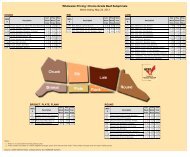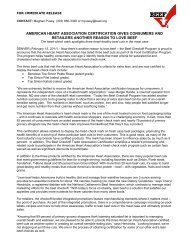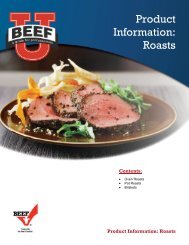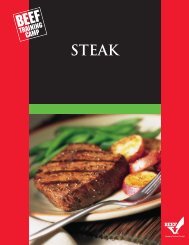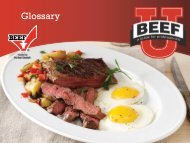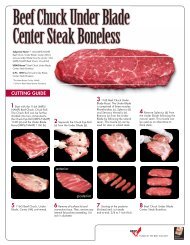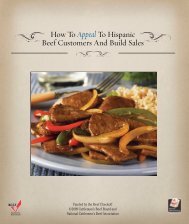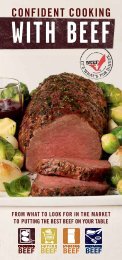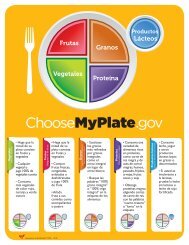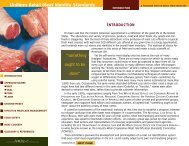NCBA BTC 2 S14 - BeefRetail.org
NCBA BTC 2 S14 - BeefRetail.org
NCBA BTC 2 S14 - BeefRetail.org
You also want an ePaper? Increase the reach of your titles
YUMPU automatically turns print PDFs into web optimized ePapers that Google loves.
GLOSSARY<br />
KOSHER MEAT<br />
Meat from cloven-hooved animals<br />
such as cattle and hogs that have<br />
been slaughtered according to<br />
Jewish practices.<br />
KOSHER-STYLE<br />
Used in reference to pure beef sausage<br />
and corned beef that is seasoned with<br />
garlic and spices, imparting a flavor<br />
similar to real kosher products. This<br />
term is illegal for use in advertising<br />
or product description in a number<br />
of states.<br />
LABEL<br />
The USDA Meat Inspection Program<br />
requires that a descriptive label be<br />
prominently displayed on each<br />
box/package of inspected product.<br />
The label must include: (1) the name<br />
of the product, (2) an ingredient list,<br />
(if applicable), (3) the name and place<br />
of business of manufacturer, (4) net<br />
quantity/weight statement, (5) official<br />
inspection legend, and (6) any other<br />
information required by regulations<br />
(such as a “Safe Food Handling” label<br />
on ground beef packages).<br />
LAID OUT PACK<br />
A portion, single thickness on<br />
separating sheets or boards.<br />
LEAKER<br />
A vacuum packaged product that has<br />
completely lost its vacuum, allowing air<br />
to “leak” into the package.<br />
LEAN<br />
(Industry Definition)<br />
The muscle portion of a meat product,<br />
excluding fat and bone.<br />
(Used as a Nutritional Claim)<br />
Lean is a term used to describe the fat<br />
content of meat, poultry, seafood, and<br />
game meats. Lean = less than 10g fat,<br />
4.5g or less saturated fat, and less<br />
than 95mg cholesterol per serving and<br />
per 100g.<br />
LEAN FINELY TEXTURED BEEF<br />
Lean beef (less than 10% fat) that<br />
has been separated specifically from<br />
approved beef trimmings through<br />
a mechanical separation system<br />
(not to be confused with “Mechanically<br />
Separated Beef”). Most naturally<br />
occurring sinew and connective tissue<br />
has been removed.<br />
“LEAN” LABELS<br />
Label claim that must be substantiated<br />
by the USDA. (see Lean (Used as a<br />
Nutritional Claim))<br />
LEAN-TO-FAT RATIO<br />
The relative proportion (ratio) of the<br />
lean content to the fat content in a<br />
fresh meat product, usually expressed<br />
as a percentage. As the percentage of<br />
lean increases in a meat product, the<br />
cost per pound of the product also<br />
increases. (see Fifty/Fifty Trimmings)<br />
LIFTER MEAT<br />
(see Blade Meat)<br />
LIGHT<br />
Light is a term used on food labels and<br />
can mean one of two things:<br />
1. That a nutritionally-altered product<br />
contains one-third fewer calories or<br />
half the fat of the reference food. If<br />
the food derives 50 percent or more<br />
of its calories from fat, the reduction<br />
must be 50 percent of the fat.<br />
2. That the sodium content of a<br />
low-calorie, low-fat food has been<br />
reduced by 50 percent. In addition,<br />
“light in sodium” may be used on<br />
food in which the sodium content<br />
has been reduced by at least<br />
50 percent.<br />
The term “light” still can be used to<br />
describe such properties as texture and<br />
color, as long as the label explains the<br />
intent (i.e., “light brown sugar” and<br />
“light and fluffy”).<br />
LISTERIA MONOCYTOGENES<br />
A bacterium that can be found<br />
throughout the environment, including<br />
soil and water, and also may be carried<br />
by humans and animals. Listeria can<br />
cause severe illness, especially in<br />
vulnerable populations, including<br />
pregnant women, the elderly and those<br />
with weakened immune systems.<br />
Although Listeria is destroyed by<br />
cooking and pasteurization, it can grow<br />
readily at refrigeration temperatures.<br />
LIQUID IMMERSION FREEZING<br />
A process of freezing meat by<br />
immersing or spraying sealed<br />
packages of meat in a super-cooled<br />
liquid, often used for freezing poultry.<br />
LIQUID TENDERIZATION<br />
To use any enzymatic solutions to<br />
tenderize meat cuts.<br />
LOIN END<br />
(see Hip)<br />
LONDON BROIL<br />
Originally a recipe for broiled Beef<br />
Flank Steak carved in thin slices, the<br />
name London Broil now applies to<br />
a variety of usually boneless cuts,<br />
such as Top Round Steak and Chuck<br />
Shoulder Steak, that can be broiled.<br />
MAP<br />
(see Modified Atmosphere Packaging)<br />
MARBLING<br />
Intramuscular fat or flecks of fat<br />
within the lean muscle that enhances<br />
palatability by increasing juiciness<br />
and flavor. The amount of marbling<br />
relates to quality grading in beef, with<br />
greater amounts of marbling resulting<br />
in higher quality grades. There are ten<br />
degrees of marbling, ranging from<br />
“abundant” to “devoid.”<br />
MARINADE<br />
Seasoned liquid used to give flavor to<br />
meat and, in some cases, to tenderize<br />
less tender cuts. Meat is allowed to<br />
stand in the marinade before cooking.<br />
Tenderizing marinades contain an<br />
acidic ingredient such as lemon juice,<br />
vinegar, salsa or yogurt.<br />
MARINATE, MARINATED<br />
To treat with a marinade. To be labeled<br />
“marinated,” a product must use a<br />
marinade, a mixture in which food is<br />
either soaked, massaged, tumbled or<br />
injected in order to enhance taste,<br />
tenderness or other sensory attributes<br />
such as color or juiciness.<br />
MARROW<br />
An edible, fatty substance found in the<br />
center of bones.<br />
MARROW BONES<br />
Refers to the large round bones and<br />
shank bones of the Round and Chuck<br />
(excluding knuckle bones) that contain<br />
significant amounts of marrow. The<br />
bones are usually cut into shorter<br />
pieces to expose the marrow.<br />
14-9



